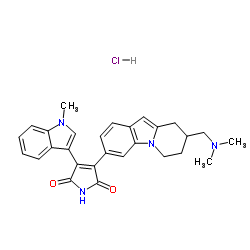Bisindolylmaleimide XI hydrochloride

Bisindolylmaleimide XI hydrochloride structure
|
Common Name | Bisindolylmaleimide XI hydrochloride | ||
|---|---|---|---|---|
| CAS Number | 145333-02-4 | Molecular Weight | 489.01 | |
| Density | N/A | Boiling Point | N/A | |
| Molecular Formula | C28H29ClN4O2 | Melting Point | N/A | |
| MSDS | USA | Flash Point | N/A | |
Use of Bisindolylmaleimide XI hydrochlorideBisindolylmaleimide XI hydrochloride (Ro 32-0432) is a potent, selective and orally active PKC inhibitor with IC50s of 9 nM, 28 nM, 31 nM, 37 nM, and 108 nM for PKCα, PKCβI, PKCβII, PKCγ, and PKCε, respectively[1][2]. |
| Name | 3-[8-[(dimethylamino)methyl]-6,7,8,9-tetrahydropyrido[1,2-a]indol-3-yl]-4-(1-methylindol-3-yl)pyrrole-2,5-dione,hydrochloride |
|---|---|
| Synonym | More Synonyms |
| Description | Bisindolylmaleimide XI hydrochloride (Ro 32-0432) is a potent, selective and orally active PKC inhibitor with IC50s of 9 nM, 28 nM, 31 nM, 37 nM, and 108 nM for PKCα, PKCβI, PKCβII, PKCγ, and PKCε, respectively[1][2]. |
|---|---|
| Related Catalog | |
| Target |
PKC-α:9 nM (IC50) PKC-βI:28 nM (IC50) PKC-βII:31 nM (IC50) PKC-γ:37 nM (IC50) PKC-ε:108 nM (IC50) |
| In Vitro | Bisindolylmaleimide XI hydrochloride (Ro 32-0432) inhibits IL-2 secretion, IL-2 receptor expression in, and proliferation of, peripheral human T-cells stimulated with phorbol ester together with phytohemagglutin or anti-CD3, but does not inhibit IL-2 induced proliferation in cells already stimulated to express IL-2 receptors. Proliferation of the influenza peptide antigen HA 307-319-specific human T-cell clone (HA27) after exposure to antigen-pulsed autologous presenting cells is also inhibited by Bisindolylmaleimide XI hydrochloride[2]. PKC inhibition with Bisindolylmaleimide XI hydrochloride (Ro 32-0432; 1 μM) decreases the proportion of apoptotic cells (-21%) in retinal progenitor cells (RPCs)[3]. |
| In Vivo | Oral administration of Bisindolylmaleimide XI hydrochloride inhibits subsequent phorbol ester-induced edema in ratss. Induction of more physiologically T-cell driven responses such as host vs. graft responses and the secondary paw swelling in adjuvant-induced arthritis are also inhibited by Bisindolylmaleimide XI hydrochloride[2]. |
| References |
| Molecular Formula | C28H29ClN4O2 |
|---|---|
| Molecular Weight | 489.01 |
| Exact Mass | 488.197906 |
| PSA | 59.27000 |
| LogP | 4.95500 |
| Personal Protective Equipment | Eyeshields;Gloves;type N95 (US);type P1 (EN143) respirator filter |
|---|---|
| RIDADR | NONH for all modes of transport |
|
Inhibition of PTH desensitization by inhibition of the G protein-coupled receptor kinase-5 enzyme with Ro 32-0432. Moore, J.B., et al.
FASEB J. 12 , A741, (1998)
|
|
|
Isoenzyme specificity of bisindolylmaleimides, selective inhibitors of protein kinase C.
Biochem. J. 294 , 335-337, (1993) The protein kinase C (PKC) family of isoenzymes is believed to mediate a wide range of signal-transduction pathways in many different cell types. A series of bisindolylmaleimides have been evaluated a... |
|
|
Cardiorespiratory responses to systemic administration of a protein kinase C inhibitor in conscious rats.
J. Appl. Physiol. 84 , 641-648, (1998) Although protein kinase C (PKC) is an essential component of multiple neurally mediated events, its role in respiratory control remains undefined. The ventilatory effects of a systemically active PKC ... |
| 3-{8-[(Dimethylamino)methyl]-6,7,8,9-tetrahydropyrido[1,2-a]indol-3-yl}-4-(1-methyl-1H-indol-3-yl)-1H-pyrrole-2,5-dione hydrochloride |
| 3-{8-[(Dimethylamino)methyl]-6,7,8,9-tetrahydropyrido[1,2-a]indol-3-yl}-4-(1-methyl-1H-indol-3-yl)-1H-pyrrole-2,5-dione hydrochloride (1:1) |
| 1H-Pyrrole-2,5-dione, 3-[8-[(dimethylamino)methyl]-6,7,8,9-tetrahydropyrido[1,2-a]indol-3-yl]-4-(1-methyl-1H-indol-3-yl)-, hydrochloride (1:1) |